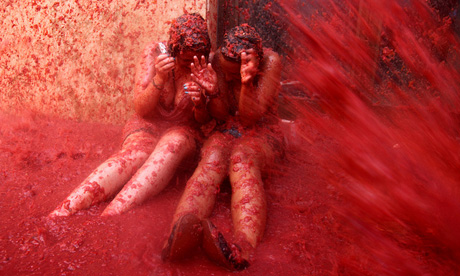
Obstructive crowds, fast-moving action, tonnes of flying tomatoes... taking pictures at a festival is tough. Here we show you how to capture the moment – and enjoy the party
An impressive array of religious, cultural and bizarre festivals fill the worldwide calendar. These events can be extremely rewarding for travel photographers, but they demand a certain amount of skill: you have to work fast and often in crowded conditions. However, with a little effort you can take home a number of memorable pictures – and have a good time.
The single most important part of photographing a festival is to plan in advance. Find out what is happening and when; if you wait until you get to the show, and then run around looking for the tourist office it will be too late. Obtain your information from a number of sources. Both events websites and information centres have given me the wrong details, and in one instance even incorrect dates.
Whether you are at a sedate religious festival or a crazy, chaotic knees-up, the key is to get a good position. Otherwise you may end up in a sea of people and only come away with photos of the back of someone’s head.
Often the best places are reserved for people taking part in the event or press photographers. But there are other options. At the Palio di Siena horse race, for example, you can pay to watch the fun from balconies. Or find a high vantage point and shoot from a distance with a telephoto lens. If there are no restrictions, then carry a small camera bag and push to the front. Close-up pictures taken with a telephoto lens can give a real sense of the action.
Festivals can be a hostile place for both you and your equipment. Dust, crowds, water – and even tomatoes – can ruin precious kit. Some fiestas, such as La Tomatina in Spain and the Songkran water festival in Thailand are extreme cases where you should either use underwater housing, or leave your camera somewhere safe and buy a small disposable one.
Underwater cases are relatively cheap, and there are ones to fit SLRs and compact cameras. For dusty conditions, protect your camera with a plastic bag or cling film. A zoom lens on a digital SLR is a good idea as it means changing the lens less often, which avoids the problem of dirt on your sensor.
Carry a spare set of batteries, and also film or memory cards. And bring a bottle of water and even a couple of energy bars. There is no point in having a spare set of batteries if you are too exhausted to keep going.
Light conditions can be tricky and beyond your control at a festival. You can be faced with contrasting midday light, overcast light or deep shadow. The light shines directly from ahead when shooting in bright conditions in the middle of the day. This produces unflattering deep shadows, especially when taking portraits. Use fill-in flash to lighten the shadows; even a simple compact camera has this setting – usually called ‘flash-always on’ or ‘forced flash’.
In low light conditions, select a faster ISO sensitivity if using digital. Set the white balance to ‘cloudy’ to remove the blue cast that occurs when working in shadows.
A higher sensitivity allows you to choose a higher shutter speed to avoid the camera shake or subject blur that can occur at fast-moving events.
A busy festival is not the time to be fiddling with your equipment. Although it doesn’t produce the best exposure, consider shooting with your camera set on ‘automatic’ and use ‘autofocus’. This way you won’t miss the action while fumbling with your aperture at key moments.
Rather than just snapping a series of random images, try to shoot a photo story. Look for pictures that work together. Use lens choice and viewpoint to create a narrative: a wide overview to establish the scene; a close up of some of the action; a behind-the-scenes shot; a classic portrait and a picture showing the crowd’s enjoyment can all be combined to give a real sense of place. Look for key events, as well as the peripheral goings-on, which make the occasion appear more balanced. For instance, at La Tomatina the crowd is warmed up by a competition to get a ham from the top of a tall, greasy pole.
Festivals are an excellent time to take portraits. People are relaxed and happy and more open to being approached than during their day-to-day lives. Celebrations also attract a wide range of individuals, making it possible to photograph a whole array of people in one place. For example, the Pushkar Camel Fair draws camel traders, holy men, pilgrims and tourists, and can be a fertile ground for shooting portraits.
A telephoto lens allows you to get in close and take a frame-filling shot, whereas a wide lens places your subject in their environment, producing a picture that says more about them and where they are.
Always ask before taking someone’s picture, even if it is just with a smile. You will be rewarded with a more characterful picture –and a friendly encounter. Digital is wonderful for portraits as you can show people the results instantly.
Above all, remember that a festival is a fantastic experience and should be fun. It would be a shame to come away with just photographs and no memories.